ZWINGER
PALACE – DRESDEN
Baroque Architecture Masterwork and Museums
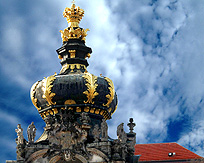 To call Dresden’s Zwinger
a palace is a bit off the mark as it never was a residence, but originated
as an “Orangerie”, that
particular palatial form of the Baroque era which expanded a royal
palace as a showcase for parties, events and just plain bragging
rights, getting its name from the new exotic citrus fruit brought back
from distant warmer climes by the burgeoning “New World” trade
ships. You couldn't call yourself a proper royal aristocrat without showing off some oranges in a show room greenhouse large
enough to be a palace. There are still a few orange trees to be found
in the Zwinger as a nod to the 18th Century, but more impressive are
the three great museums housed in the wings of one the most important
Baroque buildings in Europe.
To call Dresden’s Zwinger
a palace is a bit off the mark as it never was a residence, but originated
as an “Orangerie”, that
particular palatial form of the Baroque era which expanded a royal
palace as a showcase for parties, events and just plain bragging
rights, getting its name from the new exotic citrus fruit brought back
from distant warmer climes by the burgeoning “New World” trade
ships. You couldn't call yourself a proper royal aristocrat without showing off some oranges in a show room greenhouse large
enough to be a palace. There are still a few orange trees to be found
in the Zwinger as a nod to the 18th Century, but more impressive are
the three great museums housed in the wings of one the most important
Baroque buildings in Europe.
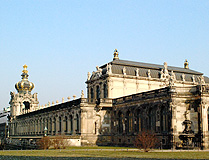 The
Saxony ruler Frederick Augustus II, referred to as Augustus the Strong,
who got his name partly from his gathering of lands and titles
and partly
from his reputed party trick of bending horseshoes, perhaps
a bit of self-promotion, envious of Louis XIV’s new palace at
Versailles, and having just gotten himself the added title of the King
of Poland,
need a showplace to celebrate. The Zwinger Palace gets its name from
a German word referring to a castle bailey, the area between the outer
defensive wall and the inner defenses. In the gun-powder age the old
medieval walls were becoming useless and the available open ground
was a perfect site for the grand exhibition halls.
The
Saxony ruler Frederick Augustus II, referred to as Augustus the Strong,
who got his name partly from his gathering of lands and titles
and partly
from his reputed party trick of bending horseshoes, perhaps
a bit of self-promotion, envious of Louis XIV’s new palace at
Versailles, and having just gotten himself the added title of the King
of Poland,
need a showplace to celebrate. The Zwinger Palace gets its name from
a German word referring to a castle bailey, the area between the outer
defensive wall and the inner defenses. In the gun-powder age the old
medieval walls were becoming useless and the available open ground
was a perfect site for the grand exhibition halls.
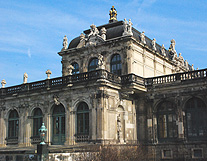 The
Zwinger was designed by court architect Matthäus Daniel Pöppelmann
to include great halls and arcade galleries around a courtyard garden,
with construction between 1711 and 1728. The inauguration was held
in 1719, unveiled for the wedding of Prince Frederick August III to
the
Archduchess Maria Josepha, the Polish born daughter of the Habsburg
Joseph I. At the time of the marriage she was the heir to the Austrian
Imperial
crown, but got pushed aside by Maria Theresa (see Schonnbrunn
Palace Vienna)
in a move to keep the lands in the Austrian line, leading to the brief war of
Austrian
succession. The building of the Zwinger stopped with August’s
death in 1733, and resumed again in 1847 with the building of the Semper
Opera
House when the architect Gottfried Semper, also designed a wing added
to the Zwinger Palace to house the galleries of the royal museums,
the Semperbau (Semper Building). The window treatments on the courtyard
side
are designed to match the older Baroque Zwinger style while the outside
facing the opera and the Elbe River bridge is pure 19th Century. The
Zwinger sustained heavy damage in WWII bombing and reconstructed to
its present state.
The
Zwinger was designed by court architect Matthäus Daniel Pöppelmann
to include great halls and arcade galleries around a courtyard garden,
with construction between 1711 and 1728. The inauguration was held
in 1719, unveiled for the wedding of Prince Frederick August III to
the
Archduchess Maria Josepha, the Polish born daughter of the Habsburg
Joseph I. At the time of the marriage she was the heir to the Austrian
Imperial
crown, but got pushed aside by Maria Theresa (see Schonnbrunn
Palace Vienna)
in a move to keep the lands in the Austrian line, leading to the brief war of
Austrian
succession. The building of the Zwinger stopped with August’s
death in 1733, and resumed again in 1847 with the building of the Semper
Opera
House when the architect Gottfried Semper, also designed a wing added
to the Zwinger Palace to house the galleries of the royal museums,
the Semperbau (Semper Building). The window treatments on the courtyard
side
are designed to match the older Baroque Zwinger style while the outside
facing the opera and the Elbe River bridge is pure 19th Century. The
Zwinger sustained heavy damage in WWII bombing and reconstructed to
its present state.
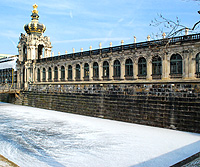 The
Zwinger’s former defensive position is still represented by
a moat on the west side, which freezes over in winter, crossed by wooden
bridge through the iconic Crown Gate, topped by one of the symbols
of Dresden, a gigantic sculpted crown flecked with gold. At the southern
gate is the Chimes Gallery, named for its clock and bell chimes. This
gallery houses the Porcelain Museum. To the east the gate leads up
steps
through the Semper Wing bordering the Semper Opera House Square and
the other palace buildings of Dresden. In the galleries of the Semper
Wing
are the Old Masters Art Museum (Alte Meisters) and the Armory Museum
(Rustkammer) of weapons and armor. Entrance to both are within the
archway (see Museums of the Zwinger).
The
Zwinger’s former defensive position is still represented by
a moat on the west side, which freezes over in winter, crossed by wooden
bridge through the iconic Crown Gate, topped by one of the symbols
of Dresden, a gigantic sculpted crown flecked with gold. At the southern
gate is the Chimes Gallery, named for its clock and bell chimes. This
gallery houses the Porcelain Museum. To the east the gate leads up
steps
through the Semper Wing bordering the Semper Opera House Square and
the other palace buildings of Dresden. In the galleries of the Semper
Wing
are the Old Masters Art Museum (Alte Meisters) and the Armory Museum
(Rustkammer) of weapons and armor. Entrance to both are within the
archway (see Museums of the Zwinger).
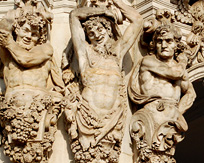 Of particular
note for exploring the Zwinger are the vase lined ballustrades and
the entrance
arches and stairs decorated with the whimsical Rococo
sculptures - the famous Nymphenbad ornate artificial waterfall of frolicking
nymphs flows in the summer, and the bacchanalia figures, representing
the theme of the celebration of relaxation and entertainment. The sculptures
and reliefs are by Balthasar Permoser assisted by Paul Hermann, also
known for his sculptures of August the Strong. Permoser usually gets
all the
credit, which is perhaps why you might find a stern disapproving face
among the happy partying satyrs. Permoser’s epic sculpture of Hercules
has been recently featured in a special exhibit at the Zwinger.
Of particular
note for exploring the Zwinger are the vase lined ballustrades and
the entrance
arches and stairs decorated with the whimsical Rococo
sculptures - the famous Nymphenbad ornate artificial waterfall of frolicking
nymphs flows in the summer, and the bacchanalia figures, representing
the theme of the celebration of relaxation and entertainment. The sculptures
and reliefs are by Balthasar Permoser assisted by Paul Hermann, also
known for his sculptures of August the Strong. Permoser usually gets
all the
credit, which is perhaps why you might find a stern disapproving face
among the happy partying satyrs. Permoser’s epic sculpture of Hercules
has been recently featured in a special exhibit at the Zwinger.
Visiting the Zwinger Palace
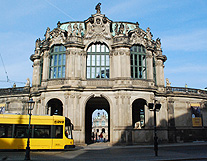 The Zwinger Palace is located in the heart of the Old City between Dresden's
palace, which houses the Green Treasure Chamber, the Court Church and
the Semper Oper served by the city tram lines. It is free to enter the
courtyard, in fact one might find it a common route to cut through the
grounds while touring around Dresden. Guided tours of the Zwinger and
the city are available through the tourism office. The Semperbau
Museums of Old Masters, Armor and the Meisner Porcelain
Collection
can
be visited
with
a single ticket for €10, or individually for €3. They are included
in the Dresden Card and City Museum Card. © Bargain
Travel Europe
The Zwinger Palace is located in the heart of the Old City between Dresden's
palace, which houses the Green Treasure Chamber, the Court Church and
the Semper Oper served by the city tram lines. It is free to enter the
courtyard, in fact one might find it a common route to cut through the
grounds while touring around Dresden. Guided tours of the Zwinger and
the city are available through the tourism office. The Semperbau
Museums of Old Masters, Armor and the Meisner Porcelain
Collection
can
be visited
with
a single ticket for €10, or individually for €3. They are included
in the Dresden Card and City Museum Card. © Bargain
Travel Europe
Find
best hotel and vacation deals in Dresden
on TripAdvisor
Web Info
Dresden
Palaces
These articles are copyrighted and the sole property of Bargain Travel Europe and WLPV, LLC. and may not be copied or reprinted without permission.
See Also:
FRAUENKIRCHE "OUR LADY" DRESDEN
SOPHIENKELLER VAULT RESTAURANT - DRESDEN
CITY NIGHT LINE - GERMAN SLEEPER TRAIN

